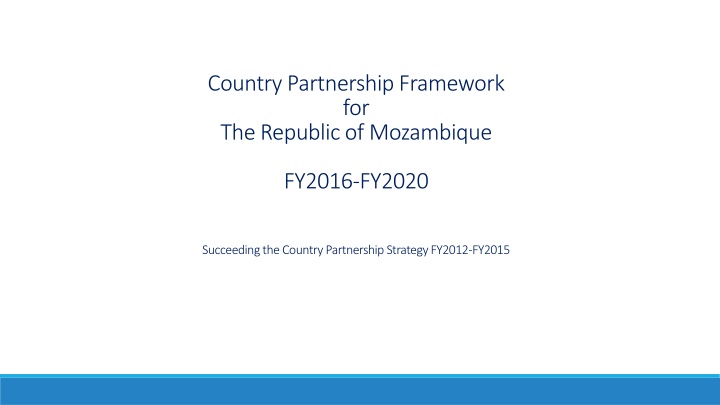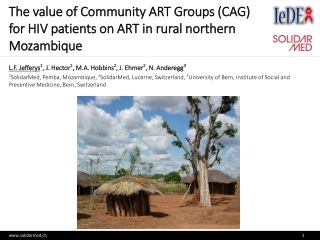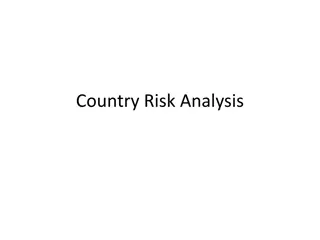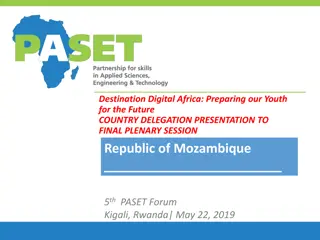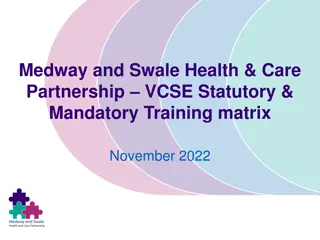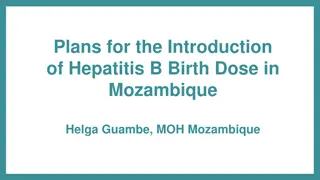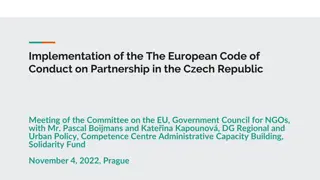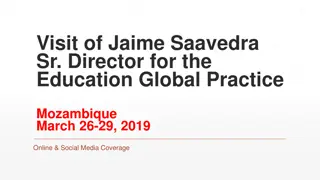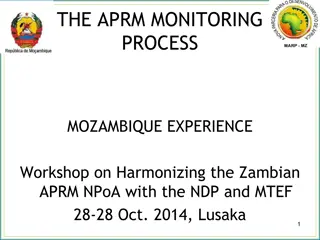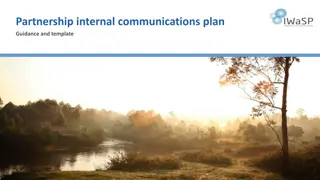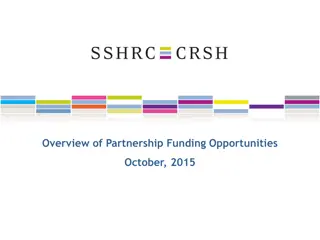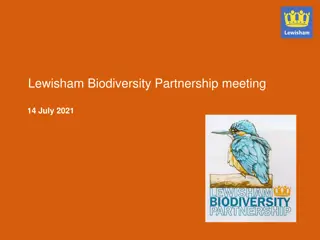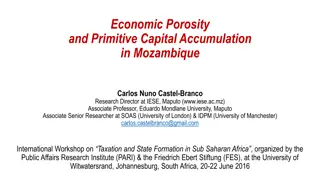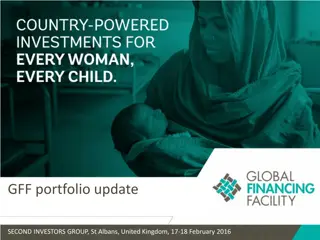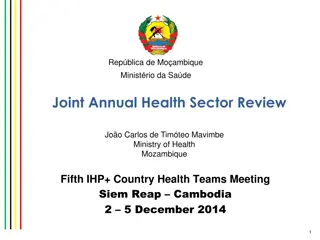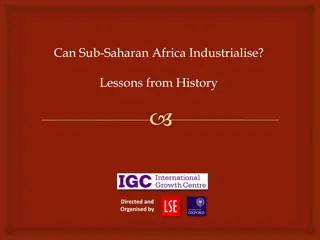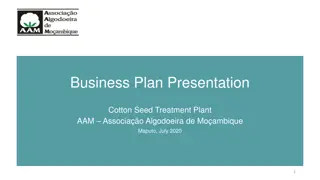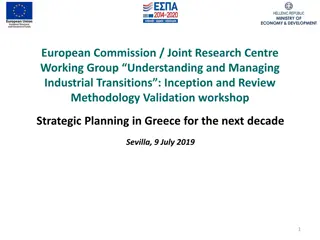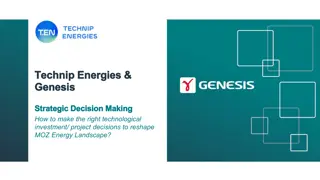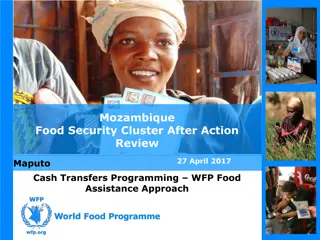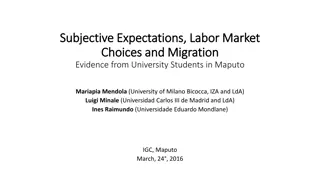Country Partnership Framework for Mozambique: Future Growth Strategies and Poverty Trends
Mozambique's Country Partnership Framework FY2016-FY2020 aims to address challenges such as demographic transitions, economic growth opportunities, and poverty reduction. Insights from systematic country diagnostics highlight the need for inclusive growth models, urban-rural linkages, and targeted interventions for vulnerable populations like female-headed households. The focus is on preparing for a young population, leveraging extractive industries for private sector development, and addressing inequalities to foster social cohesion and sustainable development.
Download Presentation

Please find below an Image/Link to download the presentation.
The content on the website is provided AS IS for your information and personal use only. It may not be sold, licensed, or shared on other websites without obtaining consent from the author.If you encounter any issues during the download, it is possible that the publisher has removed the file from their server.
You are allowed to download the files provided on this website for personal or commercial use, subject to the condition that they are used lawfully. All files are the property of their respective owners.
The content on the website is provided AS IS for your information and personal use only. It may not be sold, licensed, or shared on other websites without obtaining consent from the author.
E N D
Presentation Transcript
Country Partnership Framework for The Republic of Mozambique FY2016-FY2020 Succeeding the Country Partnership Strategy FY2012-FY2015
Foundations of the Country Partnership Framework (CPF) Programa Quinquenal do Governo 2015-2019 Systematic Country Diagnostic (SCD) Lessons learned from implementation of Country Partnership Strategy (CPS FY12-15) World Bank Country Survey 2014 Consultations with Government, national and local stakeholders, and Donor Partners 2
Looking ahead main observations from Systematic Country Diagnostic Need to prepare for an increasingly young population Mozambique is experiencing a demographic transition, with high fertility rates and declining infant mortality levels contributing to a growing population of young people. In the absence of structural changes to the economy, it will be challenging to find productive employment for new workers entering the labor market, and social services are likely to become increasingly strained. Develop a new growth model linking extractives with non-resource private sector As extractive industries are expected to play an increasingly important role in the economy, Mozambique s future growth model should strive to tighten linkages with the non-resource private sector. The development of growth corridors can help to boost diversification and private investment. Furthermore, efforts to improve infrastructure and develop value chains in the agricultural sector could increase the productivity of smallholder farmers and provide a more inclusive vehicle for growth. Inclusive growth as a vehicle for social cohesion Strengthening productivity of the agricultural sector and addressing challenges of household enterprises such as lack of infrastructure and access to finance are critical for promoting inclusive growth. As the urban population is growing in pursuit of better services and jobs, Mozambique s future growth model should harness rural-urban linkages. Cities can connect farmers to markets, provide a hub for the transportation of goods, and harness global connections. 3
Important note on poverty trends (based on 2009 data) The pace of poverty reduction is declining The distribution of poverty reduction is uneven with large geographical inequalities Poverty reduction is less responsive to economic growth than it is in other countries High inequality weakens the relationship between growth and poverty reduction The most exposed group is people living in single female-headed households. When female-head is separated or divorced headcount poverty reaches 59% 4
Mapping the PQG , the SCD priorities, and the CPF focus areas 5
From CPS to CPF enhancing focus CPS CPF 17 Objectives 11 Objectives 30 Indicators 20 Indicators 4 DPO series 2 thematic DPO series Few multisector projects More projects with multisector approach 5-6% of lending in Agriculture 15% of lending in Agriculture Education with focus on quantity Education with focus on quality Transport sector with large infrastructure investments Transport sector with more rural infrastructure 6
CPF Objectives and Indicators Focus Area 1, Promoting Diversified Growth and Enhanced Productivity 1. Increase agriculture growth including productivity and market participation a) b) c) d) Percentage of smallholder farmers marketing part of their production Percentage of production marketed Number of households and investors covered by formal land user rights Number of farmers connected by agribusiness investments 2. Strengthen local private sector and improve access to finance a) b) Number of jobs supported/generated Number of MSME loans supported by private sector clients 3. Expand access to reliable and efficient electricity supply a) b) Average interruption frequency per year Rate of electricity losses 7
Focus Area 2, Inclusiveness and Human Capital 4. Enhancing the skills base a) b) c) Primary completion rate Research institutions/organizations or companies partnering with targeted researchers Matching grants with skills development deployed at MSMEs to promote access to business development services and access to credit 5. Improve health service delivery for the most vulnerable a) b) Coverage of institutional deliveries Contraception prevalence rate 6. Extend coverage of social protection programs as a means to contribute to productive inclusion a) Percentage of extreme poor covered by safety nets programs 7. Improve access to water and sanitation services a) b) Percentage of urban population with access to improved water supply services Percentage of urban population with improved access to sanitation services 8
Focus Area 3, Enhancing Sustainability 8. Improve public debt and fiscal risk management a) b) c) d) Fiscal deficit Total nominal public debt Number of financial protection instruments available Strengthened institutions for management of mining and hydrocarbon sectors and resources 9. Boost benefits to local communities from management of natural resources a) Average increase in economic benefits of communities targeted by natural resources management interventions 10. Strengthen climate resilience and Disaster Risk Management a) b) Early Warning Systems operational for the Limpopo and Zambezi River Basin Number of sectoral planning instruments integrating climate adaptation and resilience 11. Promote inclusive urbanization and decentralization a) b) Accumulated increase in municipal and district own revenue Accumulated increase in municipal investments in informal urban settlements 9
Lessons from the Country Partnership Strategy FY12-15 Overall performance good o Majority of CPS outcomes achieved or mostly achieved o Good combination of DPO s and investment project in several areas o Examples of innovative design, such as P4R operation in Economic Governance But also room for improvement o Realism in design taking Government capacity into consideration o Opportunity to better connect, integrate and scale up activities o Strengthen Results Matrix 10
FY16 FY16- -20 Indicative Lending 20 Indicative Lending Project Name National IDA Other** Total FY16-17 Focus Area I: Promoting Diversified Growth Financial Sector DPO 25.0 25.0 APEI DPO Series 20.0 20.0 MZ-Agriculture NRM I 40.0 40.0 Mozambique Third Agriculture DPO 25.0 25.0 Energy Service and Sustainability Improvement* 100.0 100 Focus Area II: Investing in Human Capital AF to Education Sector Support Project 50.0 50.0 Water Service & Institutional Support II 90.0 90.0 Regional TB in Mining* 15.0 15.0 30.0 Focus Area III: Enhancing Sustainability MZ Emergency Recovery Project 40.0 40.0 Climate Change DPO 3 40.0 40.0 PRSC XI 70.0 70.0 415.0 115.0 530.0 FY18-20 Focus Area I: Promoting Diversified Growth MZ Regional Transmission Development* APEI III Smallholder Agriculture Productivity Improvement Integrated Feeder Roads Development Project MZ-Agriculture NRM II Multi-Sectoral DPO series Focus Area II: Investing in Human Capital Post Primary Education and Skills Small Towns Water and Sanitation Health/Safety Nets P4R Focus Area III: Enhancing Sustainability National Urban and Local Governance Sustainability DPO Series Mozbio II Urban Services and Institutional Dev. The amounts shown are indicative. The actual allocations will depend on: (i) the total IDA resources (ii) the country s performance rating, per capita GNI, and population (iii) the terms of IDA assistance (grants/credits) (iv) the allocation deductions associated with MDRI annual debt service foregone as applicable (v) the performance, other allocation parameters, and IDA assistance terms for other IDA borrowers (vi) the number of IDA eligible countries TBD *subject to availability of resources 11 11
Next steps Continued consultations with Government Presentation to WBG Boards 12
Thank you! 13
